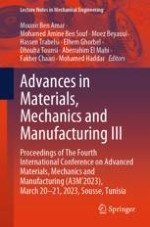This book reports on innovative materials research with a special emphasis on methods, modeling, and simulation tools for analyzing material behavior, emerging materials, and composites, and their applications in manufacturing and automotive, among others. It gathers the proceedings of the fourth International Conference on Advanced Materials Mechanics and Manufacturing, A3M2023, held on March 20-21, 2023, in Sousse, Tunisia, and organized by the Laboratory of Mechanics, Modeling, and Manufacturing (LA2MP) of the National School of Engineers of Sfax. The book covers findings from experimental analyses and numerical simulations of material behavior, characterization of new materials, structures and composites, optimization methods and Artifical Intelligence applications. Offering a good balance of fundamental research and practice-oriented findings, it provides researchers and professionals with a timely snapshot of engineering methods in mechanics, materials and manufacturing.
